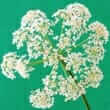Background
- Bishop's weed (Ammi majus) is an annual plant in the Apiaceae family, often cultivated for its attractive flowering stems. It is also a commonly used spice in India.
- Bishop's weed contains psoralens, which are substances that react with ultraviolet (UV) light and darken the skin. Psoralens are currently used together with UV light therapy to treat skin disorders such as psoriasis and vitiligo. Oral 8-methoxypsoralen, a drug made from bishop's weed, has been described as the drug of choice in photochemotherapy for vitiligo and psoriasis.
- Early evidence suggests that psoralen compound 8-methoxypsoralen (8-MOP) from Ammi majus may help treat vitiligo (leukoderma). However, case reports also mention potential phototoxic skin damage, phototoxic dermatitis, and pigmentary retinopathy caused by Ammi majus.
- There is currently insufficient evidence available in humans to support the use of Ammi majus for any medical condition. High-quality human studies are needed before any strong conclusion can be made about its safety and effectiveness.
References
Natural Standard developed the above evidence-based information based on a thorough systematic review of the available scientific articles. For comprehensive information about alternative and complementary therapies on the professional level, go to . Selected references are listed below.
- Ahsan, S. K., Tariq, M., Ageel, A. M., al Yahya, M. A., and Shah, A. H. Effect of Trigonella foenum-graecum and Ammi majus on calcium oxalate urolithiasis in rats. J Ethnopharmacol 1989;26(3):249-254.
View Abstract - Bethea, D., Fullmer, B., Syed, S., Seltzer, G., Tiano, J., Rischko, C., Gillespie, L., Brown, D., and Gasparro, F. P. Psoralen photobiology and photochemotherapy: 50 years of science and medicine. J Dermatol Sci 1999;19(2):78-88.
View Abstract - Dollahite, J. W., Younger, R. L., and Hoffman, G. O. Photosensitization in cattle and sheep caused by feeding Ammi majus (greater Ammi; Bishop's-Weed). Am J Vet.Res 1978;39(1):193-197.
View Abstract - El Mofty, A. M. Observations on the use of Ammi majus Linn. In vitiligo. Br J Dermatol 1952;64(12):431-441.
View Abstract - El Mofty, A. M., el Sawalhy, H., and el Mofty, M. Clinical study of a new preparation of 8-methoxypsoralen in photochemotherapy. Int J Dermatol 1994;33(8):588-592.
View Abstract - Kavli, G. and Volden, G. Phytophotodermatitis. Photodermatol. 1984;1(2):65-75.
View Abstract - Kiistala, R., Makinen-Kiljunen, S., Heikkinen, K., Rinne, J., and Haahtela, T. Occupational allergic rhinitis and contact urticaria caused by bishop's weed (Ammi majus). Allergy 1999;54(6):635-639.
View Abstract - Ossenkoppele, P. M., van der Sluis, W. G., and van Vloten, W. A. [Phototoxic dermatitis following the use of Ammi majus fruit for vitiligo]. Ned.Tijdschr.Geneeskd. 3-16-1991;135(11):478-480.
View Abstract - Singh, U. P., Singh, D. P., Maurya, S., Maheshwari, R., Singh, M., Dubey, R. S., and Singh, R. B. Investigation on the phenolics of some spices having pharmacotherapeuthic properties. J Herb Pharmacother 2004;4(4):27-42.
View Abstract - Shlosberg, A. and Egyed, M. N. Examples of poisonous plants in Israel of importance to animals and man. Arch Toxicol Suppl 1983;6:194-196.
View Abstract







